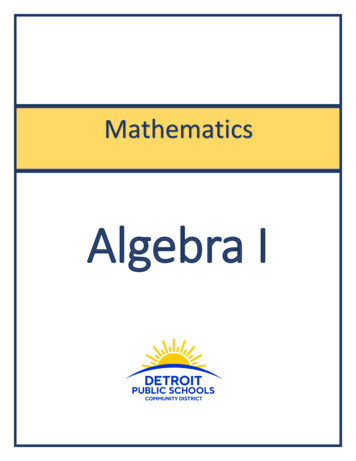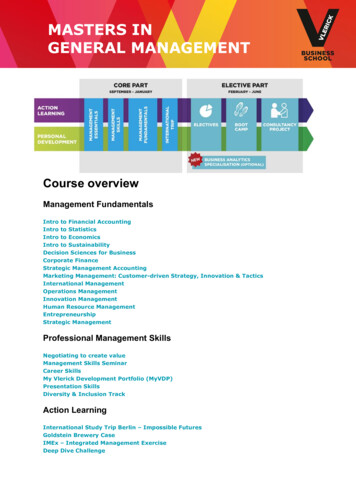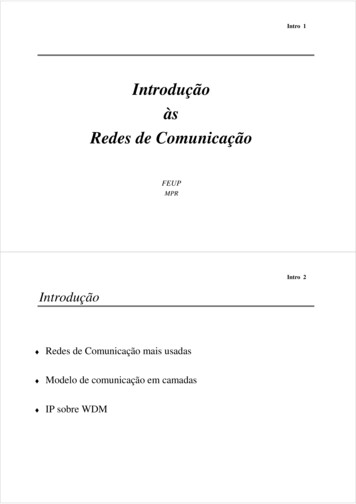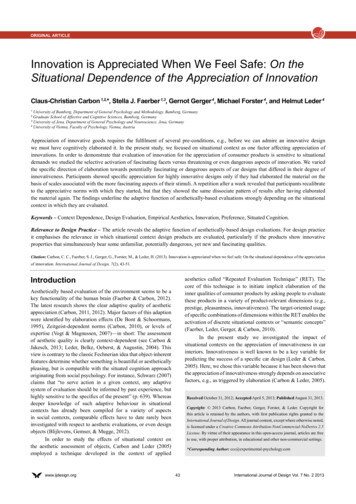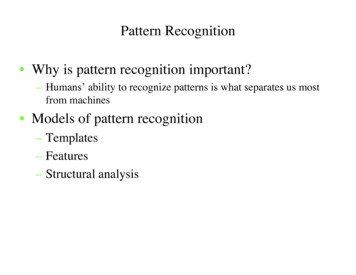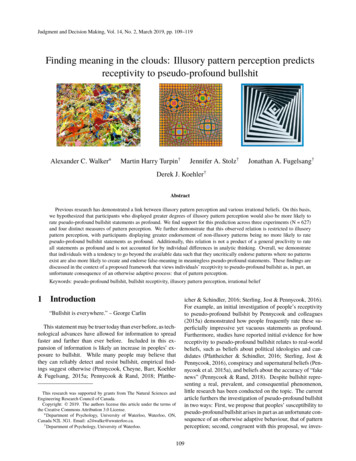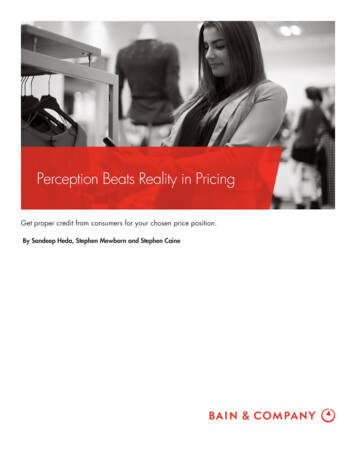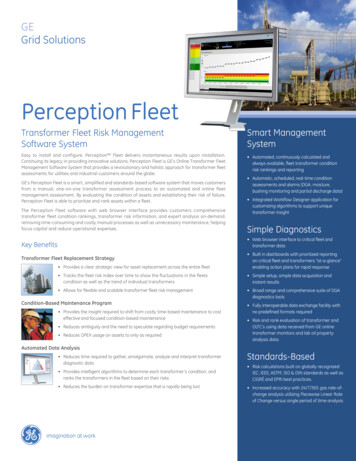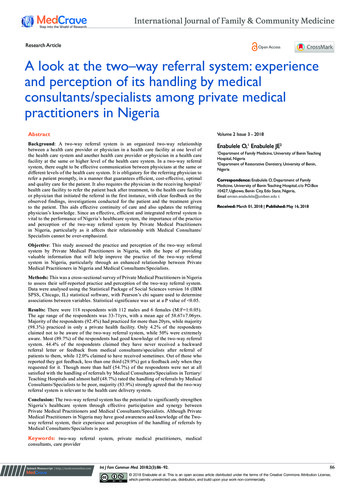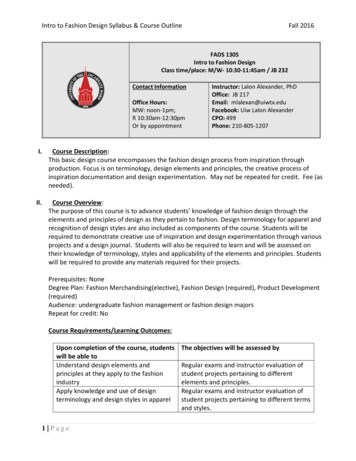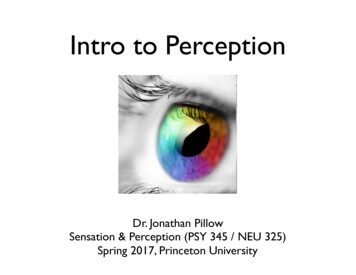
Transcription
Intro to PerceptionDr. Jonathan PillowSensation & Perception (PSY 345 / NEU 325)Spring 2017, Princeton University
Sensation and PerceptionFall 2017(PSY 345 / NEU 325)Time: Tues / Thurs 10-10:50am.Location: PNI A32.Instructor: Dr. Jonathan Pillow (pillow@princeton.edu)Office: PNI 254Office Hours: Tues. 11-12pm and by appt.AI: Na Yeon Kim (nayeon.kim@princeton.edu)Office Hours: by appt., and TBA during pre-exam and post-exam weeks: Mon. 2-4 & Fri. 10-12.Piazza:We encouragestudents ost questions to Piazza instead of sending email. This will allow otherscourseallwebsite:to benefit from your question, and will often result in a faster and more complete answer (since yourfellow students may post answers before instructors can). Please participate on Piazza, and endorsequestionsand answersas you see fit. Piazza activity will count toward the 5% participation grade!CourseDescriptionCourse Piazza page: /homeThis course will provide an introduction to the scientific study of sensationPiazza course signup link: piazza.com/princeton/fall2017/psy345neu325and perception. We tethink of the ability to perceive the world around us as an automatic process that happens ‘for free’we useoureyes, ears, nose, and other sense organs. But sensation-and-perception is anCoursewheneverrequirementsandgradingprocess that relies on exquisitely sensitive receptors and powerful computational machinery houseTwo mid-termexams(25% each),finalnervousexam (35%),plus activeparticipationin precepts.the Ourperceptualcapabilities have been honedStudentsevolutionwill be expectedto lead millionsdiscussionofof yearsat leasttoonearrivescientificpaper duringpreceptover manyin theircurrentform.andThe central focus of this cour
Location:Location: PNIPNI A32.A32.Instructor:Pillow ctor: Dr.Dr. JonathanJonathan PillowOffice:OfficeHours: : PNIPNI 254254Office Hours:SyllabusAI:AI: NaNa YeonYeon KimKim u)Officeduring s:Mon.Mon.2-4& &10-12.OfficeHours:Hours:byby appt.,appt., and TBA during2-4Fri.Fri.10-12.coursewebsite:website: Course DescriptionDescriptionCourseThiscoursecourse willwill provideprovide an introductionWetendto toThisintroduction toto fthethe abilityability toto perceiveperceive the‘forfree’thinkthe worldworld rocessthatthathappenshappens‘forfree’whenever wewe useuse ourour eyes,eyes, ears,is anactivewheneverears, nose,nose,andand and-perceptionsensation-and-perceptionis eptorsandpowerfulcomputationalmachineryhousedin inprocess that relies on exquisitely sensitive receptors and powerful computational machinery housedthebrain,brain,spinalspinal cord,cord, andand peripheralperipheral nervousbeenhonedby bythenervoussystem.system. havehavebeenhonedevolution overover manymany millionsmillions ofTheof ofthiscourseevolutionof yearsyears toto adetailedstudyof ofwill be to examine how these sensory systems work and why. We will undertake a detailed studythemajormajor sensessenses (vision,(vision, audition,audition, touch,a varietyof ightsinsightsandandmethodsmethodsfromfroma varietydisciplines (philosophy, physics, computer science, neuroscience, psychology). We will begin with a studydisciplines (philosophy, physics, computer science, neuroscience, psychology). We will begin with a studyof the physical basis for perceptual information (e.g., light, sound waves), and proceed to the biologicalof the physical basis for perceptual information (e.g., light, sound waves), and proceed to the biologicaland psychological processes by which such information is converted to percepts in the brain.and psychological processes by which such information is converted to percepts in the brain.Learning ObjectivesLearning ObjectivesThe objective of this course is to provide a thorough introduction to the biological and psychologicalTheobjectiveof thisandcourseis to provide aandthoroughintroductionthatto thebiologicaland psychologicalstudyof the senses,the computationalneural sation & Perception, 4th ed. Wolfe, J.M., Kluender, K.R., Levi, D.M., Bartoshuk, L.M., Herz, R.S., Klatzky,Sensation& Perception,ed. Wolfe,Kluender,K.R., Levi,R.L., Lederman,S.J., and4thMerfeld,D. M.J.M.,SinauerAssociates,2014.D.M., Bartoshuk, L.M., Herz, R.S., Klatzky,R.L., Lederman, S.J., and Merfeld, D. M. Sinauer Associates, 2014.
of the physical basis for perceptual information (e.g., light, sound waves), and proceed to the biologicaland psychological processes by which such information is converted to percepts in the brain.Learning ObjectivesTextbookThe objective of this course is to provide a thorough introduction to the biological and psychologicalstudy of the senses, and the computational and neural mechanisms that underlie sensation andperception.TextbookSensation & Perception, 4th ed. Wolfe, J.M., Kluender, K.R., Levi, D.M., Bartoshuk, L.M., Herz, R.S., Klatzky,R.L., Lederman, S.J., and Merfeld, D. M. Sinauer Associates, 2014.The textbook has a companion website with overviews, study aides, essays on select topics, as well assome nice demonstrations of perceptual illusions we’ll discuss in eadingsAdditional readings from the primary scientific literature will be assigned weekly, to be discussedduring precepts. List available at: dings.html
Sensation & Perception, 4th ed. Wolfe, J.M., Kluender, K.R., Levi, D.M., Bartoshuk, L.M., Herz, R.S., Klatzky,R.L., Lederman, S.J., and Merfeld, D. M. Sinauer Associates, 2014.PreceptsThe textbook has a companion website with overviews, study aides, essays on select topics, as well assome nice demonstrations of perceptual illusions we’ll discuss in eadingsAdditional readings from the primary scientific literature will be assigned weekly, to be discussedduring precepts. List available at: dings.htmlExpectations: lead presentation of 1 article participate in discussion of other articlesPlease sign up to present next 7/readings.html
fellow students may post answers before instructors can). Please participate on Piazza, and endorsequestions and answers as you see fit. Piazza activity will count toward the 5% participation grade!GradingCourse Piazza page: /homePiazza course signup link: piazza.com/princeton/fall2017/psy345neu325Course requirements and gradingTwo mid-term exams (25% each), and cumulative final exam (35%), plus active participation in precepts.Students will be expected to lead discussion of at least one scientific paper during precept andparticipate in discussion of jointly-presented papers (i.e. when there is no assigned presenter).Participation grade will be determined by the AI in consultation with the instructor, based on thispresentation (10%) and participation (5%) in discussions led by other students.Note also (very important!): all students must complete a Research Participation Assignment to receivecredit for this course (see final page of syllabus).PhilosophyLearning (like perception itself) is an active process. The more actively students engage with coursematerials and ideas, the more they will learn. The goal of this course is not so much to convey a set offacts as to introduce a discipline and its methods of inquiry. Our primary aims will be to dissect theideas presented in the textbook and readings, to challenge accepted theories of perceptual phenomena,and generate new ideas and experimental hypotheses about how our percepts of the world areconstructed.Tentative schedule of topics and readings:
How to do well in this course Come to class!– Ask questions– Answer questions Read the textbook before classTake good notes review themForm study groupsIf you have questions, please don’t waituntil the night before the exam – ask onpiazza / come to office hours
What is Perception?stuff in the world
What is Perception?stuff in the worldperceptsprocess for: extracting information via the senses forming internal representations of the world
Outline:1. Philosophy: What philosophical perspectives inform ourunderstanding and study of perception?2. General Examples why is naive realism wrong? what makes perception worth studying?3. Principles & Approaches modern tools for studying perception
Epistemology theory of knowledge Q: where does knowledge come from?Answer #1: Psychological Nativism the mind produces ideas that are notderived from external sources
Epistemology theory of knowledge Q: where does knowledge come from?Answer #1: Psychological Nativism the mind produces ideas that are notderived from external sourcesAnswer #2: Empiricism All knowledge comes from the sensesProponents: Hobbes, Locke, Hume newborn is a “blank slate” (“tabula rasa”)
Epistemology theory of knowledge Q: where does knowledge come from?Answer #1: Psychological Nativismvs.Answer #2: Empiricism resembles “nature” vs. “nurture” debate extreme positions at both ends are a bit absurd
Metaphysics
Metaphysics theory of reality Q: what kind of stuff is there in the world?Answer #1: Dualism there are two kinds of stuff usually: “mind” and “matter”Answer #2: Monism there is only one kind of stuff“materialism”(physical stuff)“idealism”(mental stuff)
René Descartes (1596–1650)“Meditations On First Philosophy”,1641 undertook a program of “radicalskepticism”: decided to discardany idea that can be doubted senses can be fooled all sense data could be caused by an “evil demon” concluded that the only thing he could be certain of wasthat he existed.(“cogito ergo sum” “I think, therefore I am”)
Descartes: “Dualism” - there are two kinds of stuff- mental stuff (non-spatial, non-physical)- physical stuff (possesses no mental properties)Problem: how can the physical and mental stuff interact?
Modern versions of dualism“homunculus” - little manThe person who sits insideour head and is responsible for“perceiving” what we see.Prevalent conception, even in neuroscience today.
Alternative theory: “Monism” - only one kind of stuffSpecifically: “Materialism” - physical matter andenergy is all that exists- challenge is to come up with a story that explainshow physical stuff can have “mental” properties(consciousness, awareness, etc)
Philosophy of MindQ: what is the relationship between “things in theworld” and “representations in our heads”?
1. Naive Realism (or “common sense realism”) We perceive the world “as it is” Our minds have direct access to realityexternalrealityexact mapof reality
2. Idealism The only reality is that of mind / ideas There is no evidence for / reason to believe in anexternal worldreality?
2. IdealismDescartes’ supposition:evildemon
2. IdealismBishop Berkeley (1685–1753)- idealist, empiricistrealityGOD
Modern variants: Brain in a vat
Brain in a vat paradox“ What is real? How do youdefine real? If you’re talkingabout what you can feel,what you can smell, what youcan taste and see, then realis simply electrical signalsinterpreted by your brain.This is the world that youknow.”—Morpheus in The Matrix,1999(movie clip)http://www.youtube.com/watch?v WnEYHQ9dscY
3. Representative Realism We perceive the external world indirectly &imperfectly, via intermediate “sense data”representationof realityexternalrealitysense dataprocessing
Note: idealism is not testable or disprovable! science can’t “prove” that the external world exists or that we have any kind of access to itWe need some pragmatic assumptions to get started: there is an external world we have (indirect) access to it via our senses
Philosophical position of this course: Empiricism - knowledge from senses (obviously!) Materialism - only one kind of stuff (matter/energy) Representative Realism - indirect knowledge ofworld, via the senses Functionalism - understanding the “function” of thesensory systems is all that we need to know to“understand” them.
In this course, “understanding” perception means:1. We can write down an algorithm for how aperceptual task is performed(i.e., we could design a computer / AI to perform the same task)2. Knowing where and how the algorithm isimplemented in the nervous system.
Philosophy Learning (like perception itself) is an active process. The more actively students engage with course materials and ideas, the more they will learn. The goal of this course is not so much to convey a set of facts as to introduce a discipline and its me

